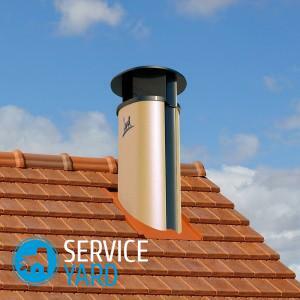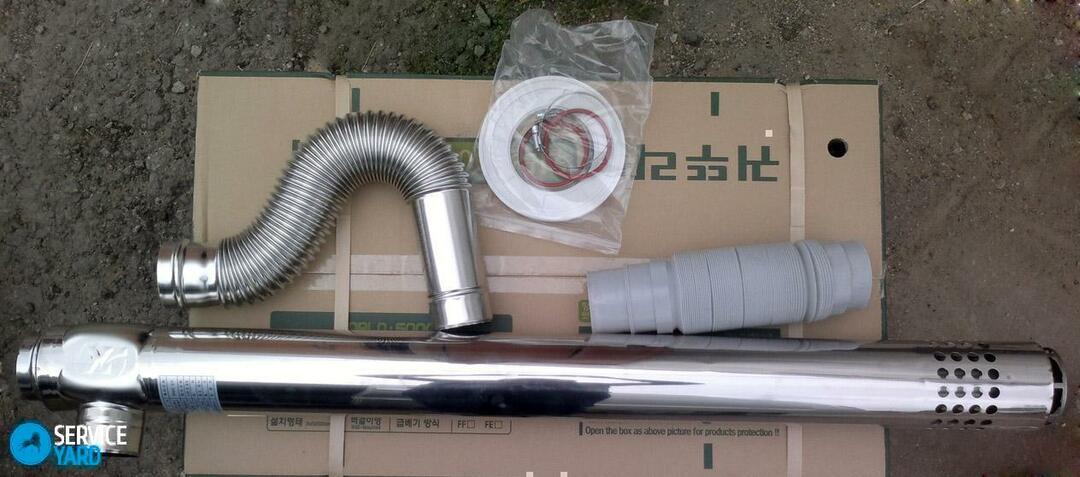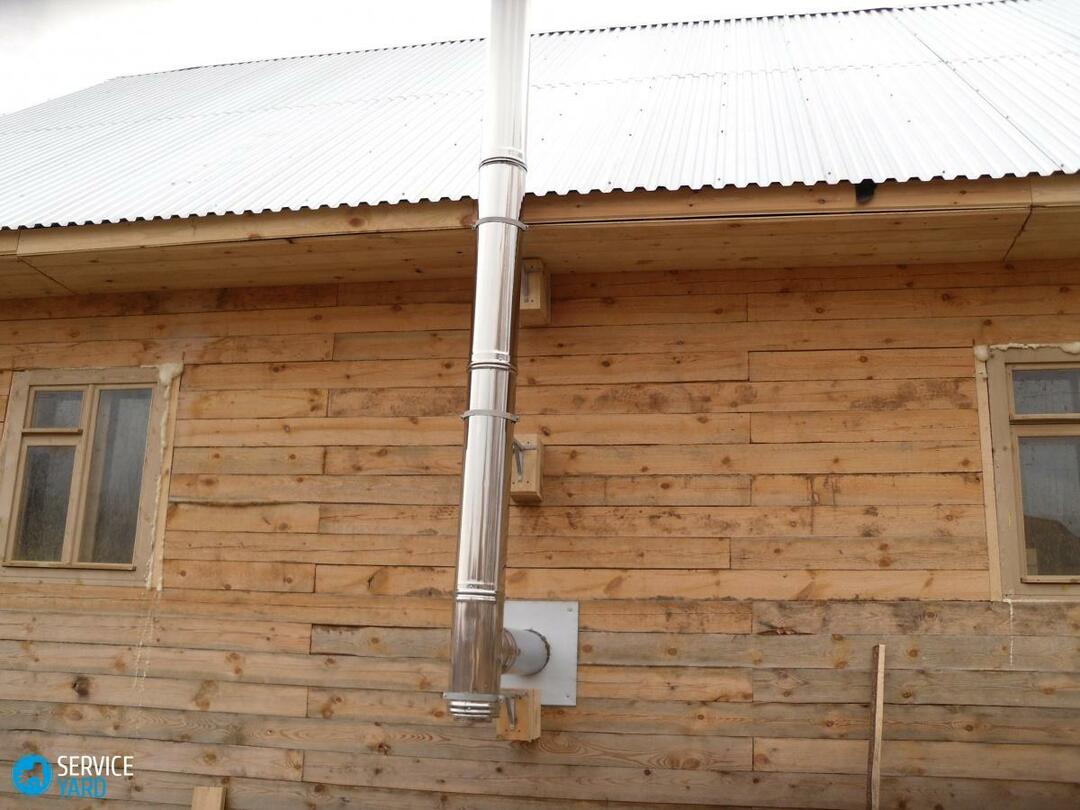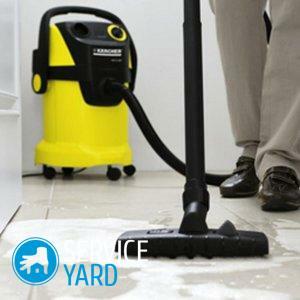
- Why do I need a chimney?
- Features of the chimney device
- Which chimney is better for a gas boiler?
- How to properly install a chimney on a gas boiler? Basic requirements of
- How to make a chimney for a gas boiler in a private house with your own hands?
- Installation of a chimney for a gas boiler in a private house. Insulation
Do I need a chimney for a gas boiler in a private house?- Of course. Only in this case will the safety and good work of the entire heating system be ensured.
The design of the smoke extraction system should be carefully thought out and the installation carried out correctly. Errors will result in insufficient traction, costs will increase, the output of combustion products outside will be incomplete. To minimize costs and improve the efficiency of the boiler, when installing the smoke pipe should take into account the advice of experts. In this article you will find exhaustive information on how to make a chimney for a gas boiler, and how to properly install it.
to the contents ↑Why do I need a chimney?
The chimney is a system that ensures the disposal of combustion products from the living area. If it is correct to make a chimney for a gas boiler, it is possible to achieve the optimum operation of the entire heating system:
- Ensure high productivity of the gas boiler( increase the efficiency level);
- Improve the efficiency of the heating system;
- Secure all tenants at home;
- Provide comfortable heating of the living area;
- Use the boiler for a long time without any problems.
Features of the chimney device
Regardless of the type of chimney, it includes the following elements:
- Smoke extraction pipe;
- Feedthrough;
- Adapter for connection of the boiler connection to the flue pipe;
- Mounting brackets and clamps;
- Telescopic tubes;
- Tee with condensate drain pipe;
- Taps;
- Cone-shaped tip.
Which chimney is better for a gas boiler?
Chimneys for gas boilers can be made from different materials. Consider the most common solutions. Thus, you can choose for yourself the most optimal option.
Brick chimney
Chimney made of such material is a design not of the past, but even the century before last. Its features include:
- Such a system has a complex design, its installation takes a long time and leads to significant financial costs for its arrangement.
- In addition to all this, the brick chimney for many significant indicators is inferior to modern chimneys.
Important! Nevertheless, brick is a solid, environmentally friendly material, the chimney from which can be used for decades.
Chimney made of galvanized pipe
One of the best and most effective is the construction of a pipe type "sandwich".Today, manufacturers offer a wide range of such chimneys, which have such properties:
- Such a smoke-exhaust system is resistant to aggressive external environment and various kinds of mechanical load.
- Has a simple constructive structure: consists of two pipes of different diameter, one of which is inside the other. The gap between them is filled with non-combustible basal cotton wool.
Important! The insulation thickness is 40-50 cm, and the filling density is 120 kg / m3.
Coaxial chimney for gas boiler
This smoke extraction system is an excellent modern version with a presentable design and good performance characteristics:
- It is made according to the scheme "pipe in the pipe".
- Used for working with gas boilers with a closed combustion chamber. Such equipment takes the intake of air for burning gas from the street, and not from a room that is heated.
- The air is supplied by an external pipe, which is laid through the outer wall of the building.
- Smoke with impurities is emitted through the inner pipe.
Important! Such a device eliminates the need to install an additional ventilation system.
- Due to the specific shape of the coaxial chimney, the possibility of condensate formation on its walls is excluded, which is especially important for heating systems operating on gas fuel.

Ceramic chimney:
- It is a simple, reliable, fireproof, easy-to-install and affordable construction.
- Such a chimney consists of a ceramic pipe, wrapped with insulating material and placed in a claydite-concrete shell.
How to install the chimney correctly on a gas boiler? Basic requirements of
Regardless of the design and material chosen, the system must be constructed strictly according to the specific rules for installing a chimney for a gas boiler.
Consider the most important of them:
- The maximum allowable slope of the smoke exhaust system should not exceed 30 degrees.
- Branching in the sides of the length should not be more than 100 cm.
- The smoke exhaust system should be without benches.
- Cross sections are completely excluded.
- The knee can be no more than 3.
- The rounding should be a radius no less than the diameter of the pipe used to drain the smoke.
- To clean the system and relieve the condensation liquid during cornering, you need to install a inspection hatch.
- If a rectangular chimney is to be constructed, it should be checked that one side does not exceed the width of the other twice. In simple words - it is impossible that the design was too elongated shape.
- At the bottom of the pipe, a revision and a drip must be fitted.
- Even non-essential deflections of structural details are unacceptable.
- When building a chimney, one link should be worn on the second, at least half the diameter of the pipe.
- No gaps are allowed between the chimney elements.
- On the areas where the chimney passes overlapping and partitions, there are no any joints.
- All elements of the system must be connected as tightly as possible.
- The minimum allowable inclination of the smoke pipe relative to the heater is 0.01 degree.
- From inside, the pipes must have the most smooth walls. Any kind of roughness is highly undesirable.
- The horizontal parts of the chimney can not be a total length of more than 300 cm in the case of houses under construction and 600 cm for buildings already erected.
- The permitted distance between the surfaces of flammable materials and the pipe is at least 250 mm, between incombustible materials and the pipe - 50 mm.
- In places where the chimney crosses partitions and ceilings, it is necessary to make a high-quality thermal insulation.
Height of smoke exhaust pipe
Separately, attention should be paid to the requirements for the height of the smoke pipe against the ridge of the roof structure. It is necessary to withdraw the chimney from the wind proppant section and set it at a height:
- Above the imaginary line, laid from the roofing skate down to the horizon at a slope of 10 degrees, if the horizontal distance from the ridge exceeds 300 cm;
- At the same level with a ridge, if the chimney is at a distance of 150-300 cm from the ridge;
- Not less than 50 cm from the roof ridge, if the horizontal distance is not more than 150 cm.
Important! The chimney should be above the adjacent roof areas by at least 50 cm. In case of a flat( combined) roof, this figure should be increased to 200 cm.
to the contents ↑How to make a chimney for a gas boiler in a private house with your own hands?
On the example of the construction of a "sandwich" -system of pipes consider the order of arrangement of the chimney. Installation of a chimney for a gas boiler can be carried out in two ways - inside and outside the house.
Installation of the flue gas boiler outside the building:
- Connect the heating element to the heater nozzle, which is designed to be routed through the wall.
- Apply markings to the wall surface, based on the dimensions of the passage. Cut out the opening.
- Remove the smoke exhaust pipe from the room.
- Carefully isolate the hole and the pipe passing through it.
- Attach the tee with the revision to the pipe. Put the cap.
- Start building up the chimney, connect new links until you reach the required length.
- Install the cone-shaped tip on the pipe. It will protect the system from wind and precipitation.
- Use brackets to fasten the structure to the wall.
Important! The placement of the fixation elements must not be less than 200 cm.
- All joints of the structure should be reinforced with clamps. Pull them with wire or bolts.
- Paint the chimney with a special paint compound that is resistant to temperature changes. Thus, you will provide the material with adequate protection against rust.

Installation of a chimney for a gas boiler inside the house:
- First of all, openings for the pipe should be outlined in the ceilings and roof.
- Check the dimensions of the branch pipe with the marks, make an opening for the smoke exhaust pipe.
- Connect the adapter to the socket of the unit.
- Install the revision and tee.
- Begin to build up the chimney. In places where the pipe crosses floors, use a special protective sleeve.
- Put a stainless steel sheet on the chimney. In advance, cut out a hole in the sheet, slightly larger than the diameter of the pipe. Such a sheet should be installed on both sides of each overlap.
- Structural joints reinforce with clamps.
- If necessary, attach the pipe to the girder beams. To do this, use brackets and wall clamps.
- Install the cone shaped tip on the chimney outlet.
Important! The brackets must be installed every 400 cm, and the wall clamps - every 200 cm.
to the contents ↑Installation of a chimney for a gas boiler in a private house. Insulation of the
structure At points where flue pipe elements come into contact with flammable materials, it is necessary to arrange a reliable thermal insulation.
Procedure:
- It is necessary to coat with a basalt wool with a foil layer a through pipe.
- The insulation should be reinforced with fireproof mastic.
- In addition, on the perimeter of each opening, in the floors and partitions, use mineral wool.
Important! In the completion of the installation of chimneys for floor gas boilers, be sure that each system seam is completely sealed. To do this, apply a simple soap solution to the seams. If there are soap bubbles, then this indicates a breach of the tightness of the system. Correct any problems in the shortest time.
For the qualitative work of the heating system, you should take care of the chimney for a gas boiler in a private house. How to properly do all the installation work, described in this article. Given all the requirements, and knowing how to install a smoke exhaust pipe, the work can be done independently. Use only high-quality and reliable materials, and be sure to thoroughly check the tightness of the system. The information in the article will help you to do everything right.



